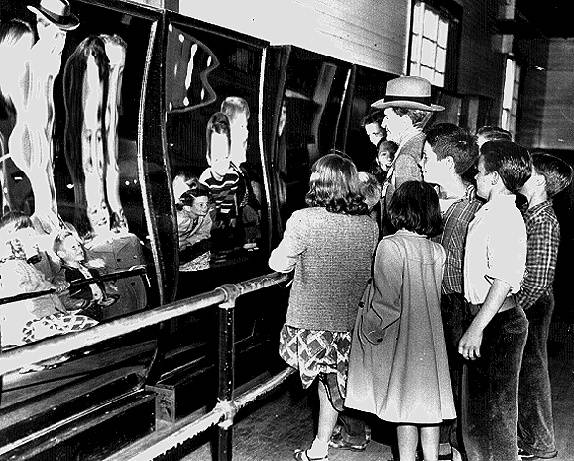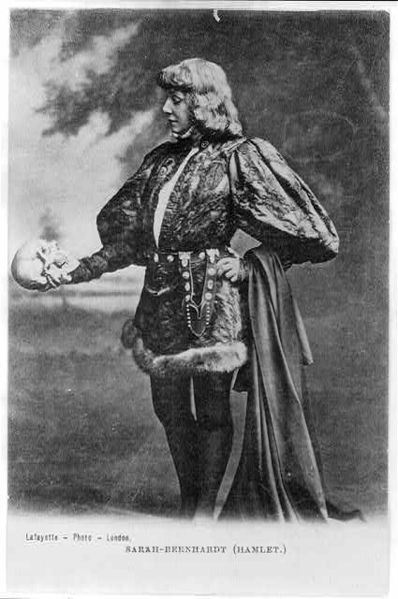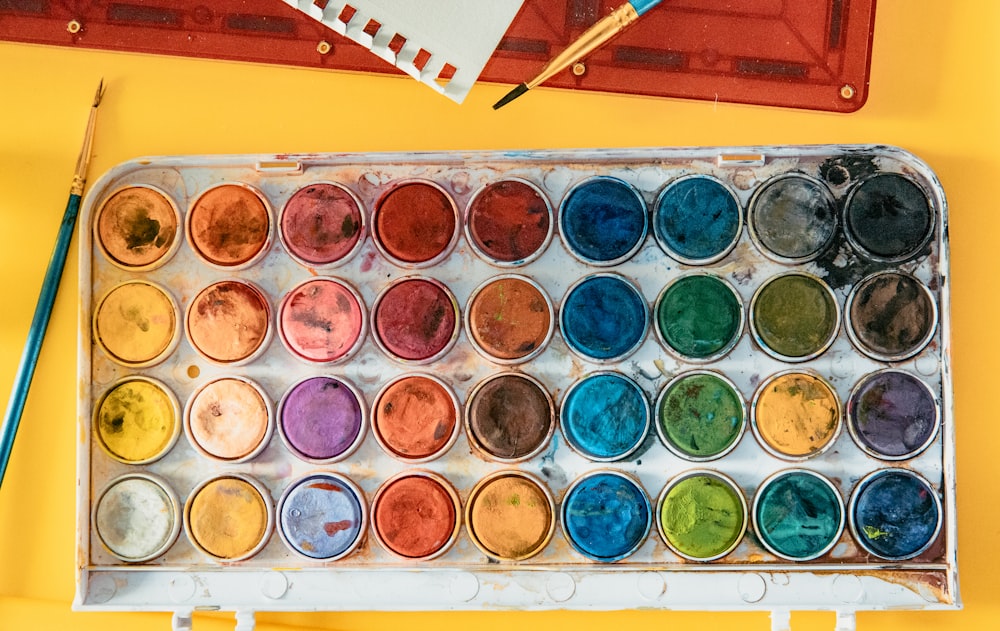In anticipation of International Translation Day, some of our favorite translators and writers share metaphors for the complex and enigmatic art of translation, from conducting to painting to squeezing a jellyfish.
“Most of the time I feel like a conduit . . . There’s an input (for example, an Arabic poem), and there’s an output (an English poem), and I’m the space where the transformation from one to the other occurs.”
—Kareem James Abu-Zeid

Funhouse mirrors. CC BY-NC-SA 3.0, via FoundSF.org.
“I also find the hall of mirrors as an apt metaphor for translation itself. Every instance of bringing meaning from one linguistic context to another finds the translator both reflecting and being reflected in the original and, naturally, in the translation.”
—Aron Aji
“Spoken word is an important category in our culture and most people require no metaphor in order to appreciate it . . . It’s odd—isn’t it?—how we sometimes have trouble appreciating the skill required to bring words from one language to life in another—and need a metaphor in order to help us do that—when we’re so readily enthusiastic about the skill of bringing written words to life by reading them aloud.”
—Esther Allen

Hydroponic greenhouse. Public domain, via the US Department of Agriculture.
“Translating a literary work can be seen as similar to what a horticulturist does by taking a rare plant out of its natural environment and bringing it to life and making grow and blossom in a foreign one . . . (I’m an avid gardener, as you might have guessed).”
—John Balcom
“Translation between languages as far removed as Japanese and English is often less a question of straining and pouring nuances from one mold into another than of reshaping the entire receptacle, especially where the publisher seeks a more readily palatable gel.”
—Alfred Birnbaum
“Translation is a handshake. It always takes place between a translator and the original author . . . With the handshake you are reaching out to them and you are also asking for their trust.”
—Ross Benjamin
“I might use the metaphor of transporting a group of people across a river, safely and soundly, in a shape they were to begin with, including their beauty, sans changes or embellishments. This metaphor brings the river, with it speed, color, undercurrents, etc. into play. What I mean by this are the cultural, social, political, etc. undercurrents that a native speaker of the source language would know while the non-native might not. It would perhaps be what is lost in translation.”
—Danuta Borchardt
“I practice Quintilian’s imitation, adjusted to my circumstances and limited abilities. Translation is collaboration between an originating writer and a rewriting translator; imitation, signals a first step toward peaceable co-existence.”
—Ronald Christ
“One often thinks of the craft of translation in terms of an actor interpreting a role, or perhaps a musician performing a piece; and yet the translator usually strives to bring as little as possible of his or her personality or self into the rendering. In that sense I see translation more as mimicry—doing as good an impression as possible of the original work in a different language.”
—Peter Constantine
“The process of translation feels like playing chess with a more talented opponent, who makes a seemingly mysterious move with the rook. Maybe a piece is left unguarded as a result, maybe the position seems more awkward, and I stare and stare at the board, trying to guess the point. Why this enjambment? Why didn’t the character respond to the flashing light? Why put the word ‘dentures’ in the middle of the sentence, rather than the end?”
—Sean Cotter
“I have an incomplete image in my mind of a translator conducting an orchestra of words, trying to present the music from the original poem with a unique and insightful interpretation.”
—Ming Di
“The metaphor I am interested in right now is one of maps. As several writers have remarked (Jorge Luis Borges, Umberto Eco, Dung Kai-Cheung), a map drawn on a scale of one-to-one would be impossible. I like to think of this imaginary map as resembling a perfect translation. Such a map, exactly the same size as what it represents, is of no use at all, just as the perfect translation—a Utopian projection—would be nowhere near as interesting as the translations we produce with their strategies and compromises.”
—Ellen Elias-Bursac
“Metaphors are tricky things. People often talk about translation as a process that necessarily involves loss. That, too, is a metaphor—it just happens to have become so widespread and dominant that people tend to treat it as literal truth rather than metaphorical description. You can only talk about translation as loss if you think of it as a process of transfer or transmission, which I don’t . . . If translation is transfer, all you can do is lose.”
—Karen Emmerich
“I think of the translator as a ghost who belongs to two worlds, two languages, two cultures, but belongs fully to neither—a figure whose very existence demonstrates that this world and that world are not separate, but coexist in the same place and at the same time.”
—Michael Emmerich
“I continue to be intrigued by a metaphor that Gregory Rabassa invoked in his book If This Be Treason: Translation and its Dyscontents. Rabassa pictures himself as the Mr. Hyde to an author’s Dr. Jekyll, and hopes that the outcome is happier than it was for Stevenson’s protagonist!”
—Shelley Frisch
“I’m a musician (a singer) so I often think of the original text as a score, and the translator’s labor as an interpretative exercise that . . . requires equal amounts of profound knowledge and technique combined with instinct, freedom, and the performer’s distinctive imprint.”
—Amaia Gabantxo

Gaga Symphony Orchestra in Italy. Photo by Carlo Alberto Cazzuffi, via Wikimedia Commons. CC BY-SA 3.0.
“I always seem to conceive of and discuss the translating process as essentially auditory, something immediately available to other people, as opposed to a silent, solitary process. I think of the author’s voice and the sound of the text, then of my obligation to hear both as clearly and profoundly as possible, and finally of my equally pressing need to speak the piece in a second language. Especially in the translation of poetry, this practice is not purely metaphorical . . . In my case, the work tends to be done viva voce.”
—Edith Grossman
“I’ve recently taken a great liking to the notion of translation as the purest form of writing: no other mode of writing is as exclusively focused on language as translation. I like this idea because it’s provocative, and rings true.”
—Jason Grunebaum
“The one that I feel best captures my own aims in translating is that of performance. In the early stages of working on a translation, I find that I’m looking for the ‘voice’ of the author or narrator much as an actor searches for a character within him- or herself, looking for the right gestures, props, and of course voice itself that will constitute an integral whole on stage.”
—Bill Johnston

Sarah Berhardt as Hamlet. Photographed by James Lafayette, 1885-1900. Library of Congress, via Wikimedia Commons.
“Translators are like ninjas—the only time you notice them is when they’re not good.”
—Etgar Keret
“Like many others, I’ve experimented with various metaphors to describe what translation is all about. Like those others, I’ve found most of them wanting. The palimpsest model comes to mind because a palimpsest involves ‘over-writing’ or, more accurately, ‘writing over,’ as well as the idea of accessing a text through the intervening layer of another text, but it also implies destruction of an original text, which certainly isn’t what we set out to do!”
—Andrea G. Labinger
“Translation is a strange art. One translates out of a faith in and love for a language, then realizes that the gaps between two languages will betray each time.”
—Krys Lee
“I gravitate to different metaphors according to the book I’m translating at any given moment. The one that suits me best right now is that translating is like copying a painting with a different color palette. The structural elements of the text can often be reproduced relatively easily, but capturing the harmonies and clashes between the subtler shades, tones, and hues is the hard part.”
—Tess Lewis
“The late Helen Lane once remarked that, ‘a case could be made for the process of translation as one of the Great Metaphors.’ Her comment could serve as a corrective: to seek an appropriate metaphor for translation is to seek a metaphor for a metaphor for an often exhilarating but also invariably messy, imperfect endeavor. I continue to look for a term or terms able to embrace the inevitably approximate nature of all verbal communication without a hint of lament.”
—Carol Maier
“My favorite is conducting music though — you have the score, but what the musicians end up playing is your interpretation of the score. And no one dings a conductor for making alterations to rhythm and pace and phrasing as being ‘inaccurate’—merely ‘interpretive.’”
—Erica Mena
“I’ve always liked the metaphor for the relationship between practice and theory in which translating is like riding a bicycle without necessarily understanding the physics behind your progress. It would be fun to come up with a new metaphor: translation is like taking a shower and forgetting to dry off, for example, but it would be a struggle to make that one serviceable.”
—Breon Mitchell
“I would gravitate toward some version of Chaim Nachman Bialik’s groom kissing the bride through the veil—translators and translated texts as lovers going through blissful times, hard times, and entanglements; lovers who may be committed, fickle, both self-centered and giving in their comingling.”
—Mihaela Moscaliuc
“I like the idea that our job is to channel our author. Get inside his or her head. This ideal carries you very far from any strict adherence to the letter, so to speak, of the source language . . . Channeling an author means fully reflecting that author’s idiosyncrasies.”
—Donald Nicholson-Smith
“I think these phrases often convey quite a lot about the society or time period in which they were written. Translators have been compared to traitors and ghosts, among other things, but in my work, I feel more like a writer who isn’t required to produce original material.”
—Allison Markin Powell

Brutus and the Ghost of Caesar. Engraving by Edward Scriven from a painting by Richard Westall, 1802. Wikimedia Commons.
“Translation is a lot like reproductive printmaking: you have an original, and your task is to reproduce it as best you can in another medium that comes with its own constraints. Hendrik Goltzius interpreted the sculpted volumes of the Farnese Hercules using only black lines on flat white paper, so in one sense both works show the same masterpiece, and in another sense they are completely different, technically unrelated pieces.”
—Alta L. Price
“I offer [students] a plethora of famous metaphors about the translation process, starting with Robert Frost’s famous ‘Poetry is what gets lost in translation.’ I then ask them to develop their own original understanding of translation by inventing their own extended metaphor.”
—Roger Sedarat
“When we translate, our performance is our reading/writing and our stage is the page . . . Can there ever be a definitive performance of Hamlet or a definitive translation of Rilke? I don’t think so, and how much poorer we would be if one could somehow be assumed or imposed.”
—Katherine Silver

Moon jellyfish (Aurelia aurita) at Gota Sagher by Alexander Vasenin, via Wikimedia Commons. CC BY-SA 3.0.
“I am partial to a metaphor that Valerie Henitiuk unearthed in an early anthology of Japanese literature where translation is compared to ‘squeezing a jellyfish.’ . . . It expresses for me both the difficulty of coming to terms with elusive meaning in a source text—meaning that tends to slip away the harder you try to grasp it—and the sense that translation can often be a process of ‘massaging’ language to loosen it up and make it more flexible.”
—Stephen Snyder
“I’ve been thinking about translation as a kind of adoption, as when one adopts a child. You take her from her home context, love and care for her, teach her what you know, and then, when she gets big enough and, you hope, has learned enough from you to live on her own, you introduce her to the world and hope she can thrive.”
—Russell Valentino

Fats Domino in concert in Normandy, France. 1992. Taken by Roland Godefroy, via Wikimedia Commons. CC BY-SA 3.0.
“The metaphor I always use I actually stole from David Markson: ‘Once, somebody asked Robert Schumann to explain the meaning of a certain piece of music he had just played on the piano. What Robert Schumann did was sit back down at the piano and play the piece of music again.’ That’s what translating is for me. I don’t need to explain the meaning of a work, I just need to sit back down and play it again, in English.”
—Alyson Waters
“My translation becomes a re-creation that reflects the original, just as the sea can reflect the sky with its moving stars, shifting clouds, gestations of the moon and migrating birds—but ultimately the sea is not the sky.”
—Sholeh Wolpé

Water covering the Bonneville Salt Flats near Wendover, Utah. 2015. By Famartin, via Wikimedia Commons. CC BY-SA 4.0.
















